Exploring Hoosier Minority Groups: Indiana's Hispanic Population
Indiana’s population has become increasingly diverse in terms of race and origin. Results from the latest census count for 2010 provide us with a rich set of information from which to gain insight into our population diversity. This article is the second of four InContext articles to provide demographic snapshots of our minority population. Hispanics comprised 6.0 percent of Indiana’s population in 2010 and will be the focus of our second snapshot. (View the first article on Indiana’s black population here.) The overview that follows focuses on population, household formation, income and education.
Population
389,707 Hoosiers reported their ethnicity as Hispanic or Latino in 2010. At the county level, Hispanics comprise anywhere from 0.7 percent (Martin County) to 16.7 percent (Lake County) of the total population (see Figure 1).
Figure 1: Hispanics as a Percent of Total Population, 2010
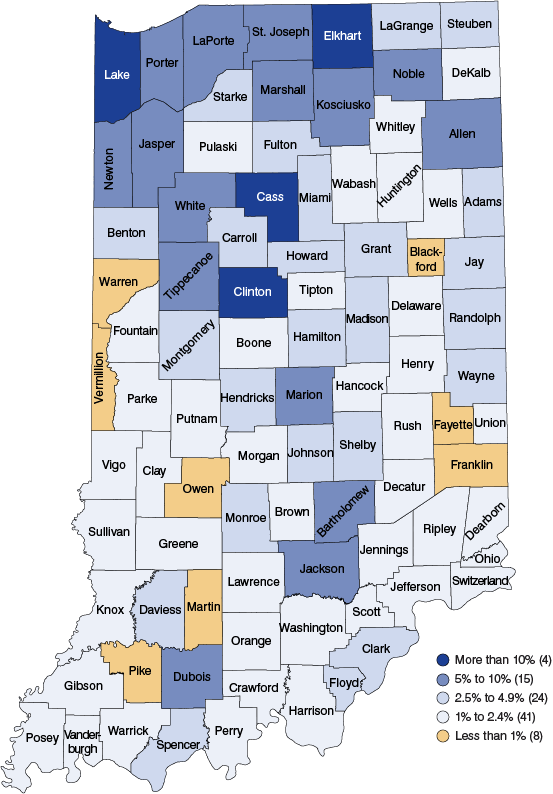
Source: IBRC, using Census 2010 data
The Census Bureau considers the Hispanic/Latino classification to be an ethnicity, not a race. That means one can be a white Hispanic, a black Hispanic, etc. Figure 2 shows the racial breakdown of the state’s Hispanic population.
Figure 2: Indiana Hispanic Population by Race, 2010
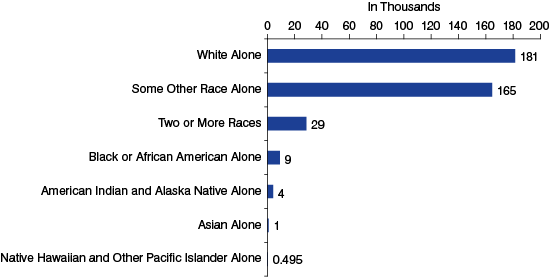
Source: IBRC, using Census 2010 data
Figure 3 shows that 76 percent of Indiana’s Hispanic population is Mexican, followed distantly by Puerto Ricans at 8 percent.
Figure 3: Indiana Hispanic Population by Type, 2010
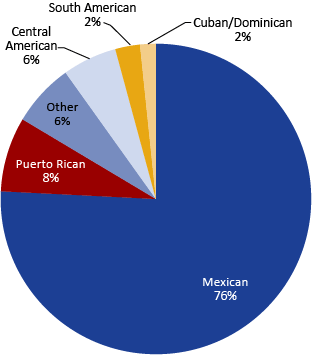
Note: Central American excludes Mexican.
Source: IBRC, using Census 2010 data
Since 2000, Indiana’s Hispanic population has grown by nearly 82 percent—an increase of 175,171 people. This growth ranged from 20.1 percent in LaGrange and Greene counties to more than 270 percent in Hendricks and Union counties. In fact, 28 counties saw their Hispanic population increase by more than 100 percent.
In addition, the Hispanic population is significantly younger than the state’s population overall (see Figure 4). The median age for Hispanics is 24.1 years, compared to 37.1 for the overall population.
Figure 4: Indiana Age Distribution, 2010
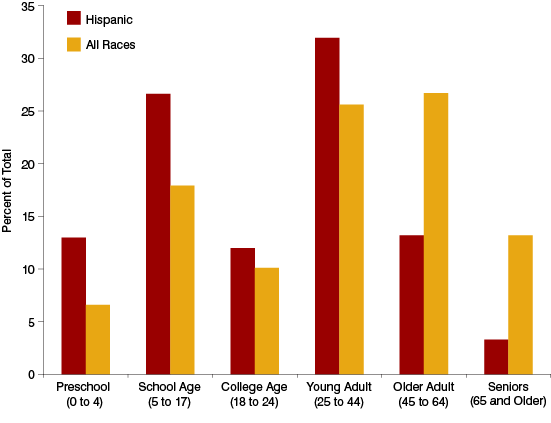
Source: IBRC, using Census 2010 data
Households
Census 2010 reports 99,136 Hispanic households in the state. (When it comes to ethnicity at the household level, the household is characterized based on the ethnicity of the primary householder.) Half of all Hispanic households were comprised of married couples, similar to the overall population, while fewer Hispanics live alone (see Figure 5).
Figure 5: Indiana Households by Type, 2010
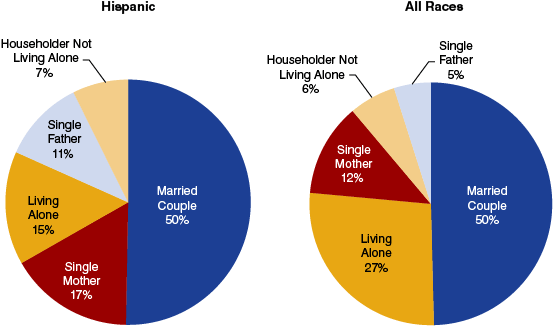
Note: The single-mother category is “female householder, no husband present” and the single-father category is “male householder, no wife present.”
Source: IBRC, using Census 2010 data
Forty-five percent of the Hispanic population lives in rented units, relative to 28 percent of the total population (see Table 1).
Table 1: Indiana Homeownership, 2010
| Indicator | Hispanic | All Races |
|---|---|---|
| Owned with a Mortgage or a Loan | 46% | 57% |
| Owned Free and Clear | 10% | 16% |
| Renter Occupied | 45% | 28% |
Note: These percentages are based on the population in occupied housing units.
Source: IBRC, using Census 2010 data
Income and Educational Attainment
Since Census 2010 did not collect any economic data, we must turn to the 2011 American Community Survey (ACS) for this information. Per capita income in 2011 was just $12,784 for Indiana’s Hispanic population, compared to $23,524 for the overall population. Meanwhile, the median household income for Indiana’s Hispanic households was $35,122—about $11,000 less than the median for all households in the state ($46,438).
The poverty rate was 34 percent for Indiana’s Hispanics according to the ACS, compared to 16 percent for the overall population.
Figure 6 shows educational attainment for the Hispanic population broken down by gender. While 13 percent of the overall population lack a high school diploma or GED, those numbers surge to 40 percent for Hispanic men and 37 percent for Hispanic women.
Figure 6: Indiana’s Adult Educational Attainment, 2011
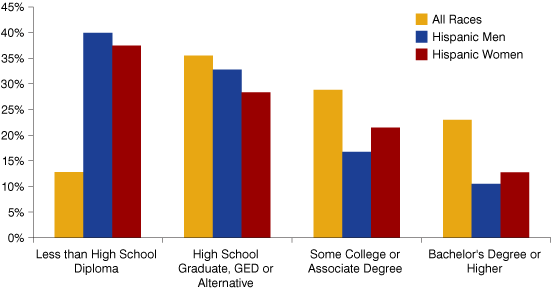
Note: Educational attainment statistics are calculated for those age 25 and older.
Source: IBRC, using American Community Survey data
Learn More
To access more data about Indiana’s Hispanic population, visit American FactFinder from the U.S. Census Bureau at https://data.census.gov, which contains data from both Census 2010 and the latest American Community Survey.
For a look into Indiana’s other minority groups, visit other articles in this series:
- Indiana’s Black Population
- Indiana’s Asian Population—Coming in the September-October Issue
- Indiana’s Native American Population—Coming in the November-December Issue
